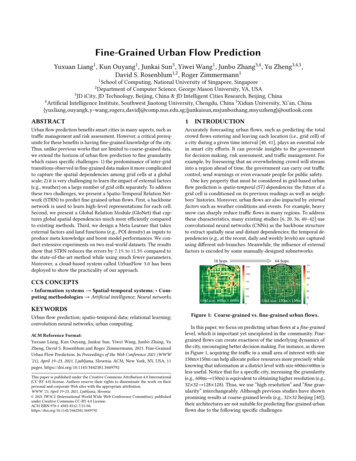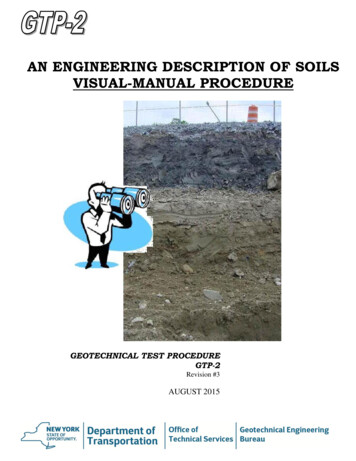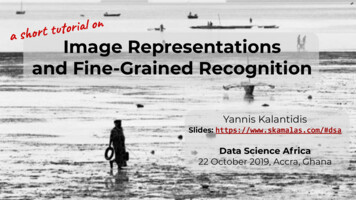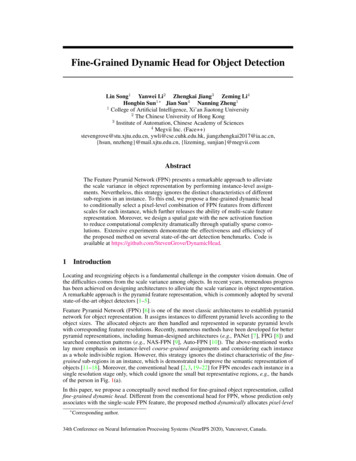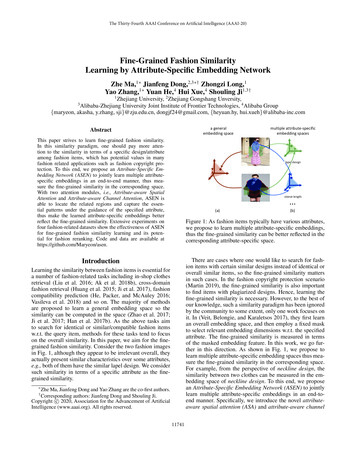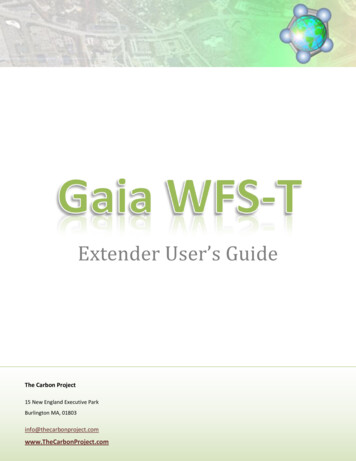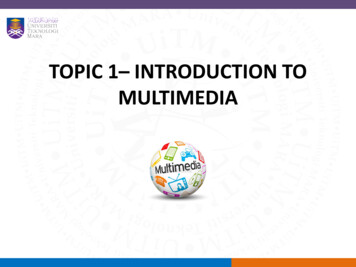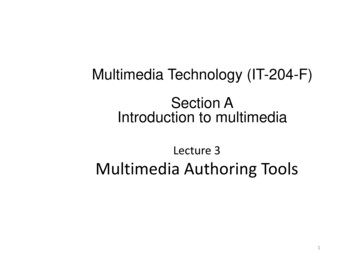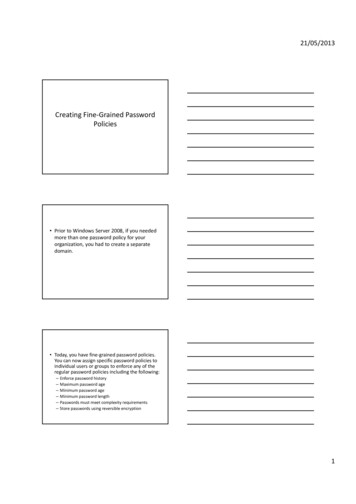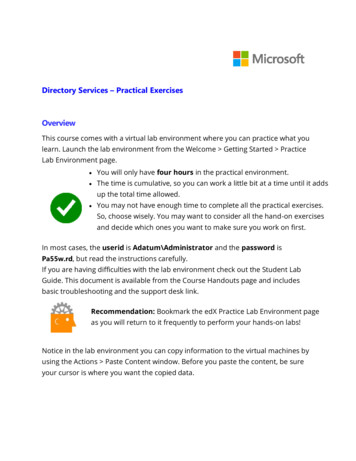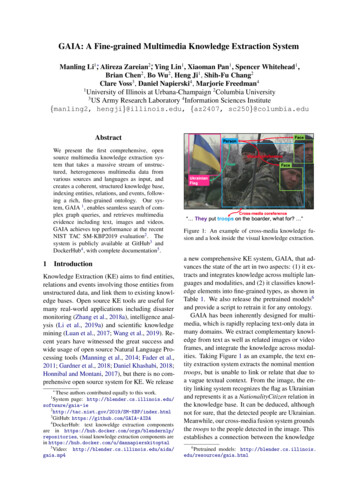
Transcription
GAIA: A Fine-grained Multimedia Knowledge Extraction SystemManling Li1 , Alireza Zareian2 , Ying Lin1 , Xiaoman Pan1 , Spencer Whitehead1 ,Brian Chen2 , Bo Wu2 , Heng Ji1 , Shih-Fu Chang2Clare Voss3 , Daniel Napierski4 , Marjorie Freedman41University of Illinois at Urbana-Champaign 2 Columbia University3US Army Research Laboratory 4 Information Sciences Institute{manling2, hengji}@illinois.edu, {az2407, sc250}@columbia.eduAbstractWe present the first comprehensive, opensource multimedia knowledge extraction system that takes a massive stream of unstructured, heterogeneous multimedia data fromvarious sources and languages as input, andcreates a coherent, structured knowledge base,indexing entities, relations, and events, following a rich, fine-grained ontology. Our system, GAIA 1 , enables seamless search of complex graph queries, and retrieves multimediaevidence including text, images and videos.GAIA achieves top performance at the recentNIST TAC SM-KBP2019 evaluation2 . Thesystem is publicly available at GitHub3 andDockerHub4 , with complete documentation5 .1IntroductionKnowledge Extraction (KE) aims to find entities,relations and events involving those entities fromunstructured data, and link them to existing knowledge bases. Open source KE tools are useful formany real-world applications including disastermonitoring (Zhang et al., 2018a), intelligence analysis (Li et al., 2019a) and scientific knowledgemining (Luan et al., 2017; Wang et al., 2019). Recent years have witnessed the great success andwide usage of open source Natural Language Processing tools (Manning et al., 2014; Fader et al.,2011; Gardner et al., 2018; Daniel Khashabi, 2018;Honnibal and Montani, 2017), but there is no comprehensive open source system for KE. We release These authors contributed equally to this work.System page: tp://tac.nist.gov/2019/SM-KBP/index.html3GitHub: https://github.com/GAIA-AIDA4DockerHub: text knoweldge extraction componentsare in s, visual knowledge extraction components arein https://hub.docker.com/u/dannapierskitoptal5Video: e 1: An example of cross-media knowledge fusion and a look inside the visual knowledge extraction.a new comprehensive KE system, GAIA, that advances the state of the art in two aspects: (1) it extracts and integrates knowledge across multiple languages and modalities, and (2) it classifies knowledge elements into fine-grained types, as shown inTable 1. We also release the pretrained models6and provide a script to retrain it for any ontology.GAIA has been inherently designed for multimedia, which is rapidly replacing text-only data inmany domains. We extract complementary knowledge from text as well as related images or videoframes, and integrate the knowledge across modalities. Taking Figure 1 as an example, the text entity extraction system extracts the nominal mentiontroops, but is unable to link or relate that due toa vague textual context. From the image, the entity linking system recognizes the flag as Ukrainianand represents it as a NationalityCitizen relation inthe knowledge base. It can be deduced, althoughnot for sure, that the detected people are Ukrainian.Meanwhile, our cross-media fusion system groundsthe troops to the people detected in the image. Thisestablishes a connection between the knowledge6Pretrained models: http://blender.cs.illinois.edu/resources/gaia.html
Figure 2: User-facing views of knowledge networks constructed with events automatically extracted from multimedia multilingual news reports. We display the event arguments, type, summary, similar events, as well as visualknowledge extracted from the corresponding image and video.extracted from the two modalities, allowing to inferthat the troops are Ukrainian, and They refers to theUkrainian government.Compared to coarse-grained event types ofprevious work (Li et al., 2019a), we followa richer ontology to extract fine-grained types,which are crucial to scenario understanding andevent prediction. For example, an event oftype Movement.TransportPerson involving an entity of type PER.Politician.HeadOfGovernmentdiffers in implications from the same eventtype involving a PER.Combatant.Sniper entity(i.e., a political trip versus a military deployment). Similarly, it is far more likely thatan event of type Conflict.Attack.Invade willlead to a Contact.Negotiate.Meet event, whilea Conflict.Attack.Hanging event is more likelyto be followed by an event of type Contact.FuneralVigil.Meet.Coarse-grained Types Fine-grained TypesEntityRelationEvent7234718761144Table 1: Compared to the coarse-grained knowledgeextraction of previous work, GAIA can support finegrained entity, relation, and event extraction with typesthat are a superset of the previous coarse-grained types.The knowledge base extracted by GAIA cansupport various applications, such as multimedianews event understanding and recommendation.We use Russia-Ukraine conflicts of 2014-2015 as acase study, and develop a knowledge explorationinterface that recommends events related to theuser’s ongoing search based on previously-selectedattribute values and dimensions of events beingviewed7 , as shown in Figure 2. Thus, this system automatically provides the user with a morecomprehensive exposure to collected events, theirimportance, and their interconnections. Extensionsof this system to real-time applications would beparticularly useful for tracking current events, providing alerts, and predicting possible changes, aswell as topics related to ongoing incidents.2OverviewThe architecture of our multimedia knowledge extraction system is illustrated in Figure 3. The system pipeline consists of a Text Knowledge Extraction (TKE) branch and a Visual Knowledge Extraction (VKE) branch (Sections 3 and 4 respectively).Each branch takes the same set of documents as input, and initially creates a separate knowledge base(KB) that encodes the information from its respec7Event recommendation demo: http://blender.cs.illinois.edu/demo/video recommendation/indexattack dark.html
Visual Entity ExtractionMultimedia NewsFaster R-CNN ClassActivationensembleMap ModelImages and Video Key FramesMTCNN FaceDetectorVisual Entity LinkingFaceNetFusion andPruningFlagRecognitionLandmark MatchingVisual Entity ringHeuristicsRulesEnglish Russian UkrainianMulti-lingual Text ContentBackground KBVisual KBTextual Mention ExtractionTextual Entity CoreferenceTextual Relation ExtractionCross-Media FusionELMo-LSTM CRFEntity ExtractorCollective Entity Linkingand NIL ClusteringAssembled CNN ExtractorVisual GroundingAttentive Fine-GrainedEntity TypingContextualNominal CoreferenceDependency basedFine-Grained Relation TypingCross-modal Entity LinkingTextual KBMultimedia KBTextual Event CoreferenceApplicationsGraph basedCoreference ResolutionNews RecommendationTextual Event ExtractionCoarse-Grained Event ExtractionBi-LSTM CRFsTrigger ExtractorCNNArgument ExtractorFine-Grained Event TypingFrameNet & Dependency basedFine-Grained Event TypingRule basedFine-Grained Event TypingFigure 3: The architecture of GAIA multimedia knowledge extraction.tive modality. Both output knowledge bases makeuse of the same types from the DARPA AIDA ontology8 , as referred to in Table 1. Therefore, whilethe branches both encode their modality-specificextractions into their KBs, they do so with typesdefined in the same semantic space. This sharedspace allows us to fuse the two KBs into a single,coherent multimedia KB through the Cross-MediaKnowledge Fusion module (Section 5). Our userfacing system demo accesses one such resultingKB, where attack events have been extracted frommulti-media documents related to the 2014-2015Russia-Ukraine conflict scenario. In response touser queries, the system recommends informationaround a primary event and its connected eventsfrom the knowledge graph (screenshot in Figure 2).3Text Knowledge ExtractionAs shown in Figure 3, the Text Knowledge Extraction (TKE) system extracts entities, relations,and events from input documents. Then it clustersidentical entities through entity linking and coreference, and clusters identical events using BP/2019/ontologies/LDCOntology3.1Text Entity Extraction and CoreferenceCoarse-grained Mention Extraction We extractcoarse-grained named and nominal entity mentionsusing a LSTM-CRF (Lin et al., 2019) model. Weuse pretrained ELMo (Peters et al., 2018) wordembeddings as input features for English, and pretrain Word2Vec (Le and Mikolov, 2014) models onWikipedia data to generate Russian and Ukrainianword embeddings.Entity Linking and Coreference We seek tolink the entity mentions to pre-existing entitiesin the background KBs (Pan et al., 2015), including Freebase (LDC2015E42) and GeoNames(LDC2019E43). For mentions that are linkable tothe same Freebase entity, coreference informationis added. For name mentions that cannot be linkedto the KB, we apply heuristic rules (Li et al., 2019b)to same-named mentions within each document toform NIL clusters. A NIL cluster is a cluster ofentity mentions referring to the same entity but donot have corresponding KB entries (Ji et al., 2014).Fine-grained Entity Typing We develop an attentive fine-grained type classification model with latent type representation (Lin and Ji, 2019). It takesas input a mention with its context sentence andpredicts the most likely fine-grained type. We obtain the YAGO (Suchanek et al., 2008) fine-grained
types from the results of Freebase entity linking,and map these types to the DARPA AIDA ontology. For mentions with identified, coarse-grainedGPE and LOC types, we further determine theirfine-grained types using GeoNames attributes feature class and feature code from the GeoNamesentity linking result. Given that most nominal mentions are descriptions and thus do not link to entriesin Freebase or GeoNames, we develop a nominalkeyword list (Li et al., 2019b) for each type to incorporate these mentions into the entity analyses.Entity Salience Ranking To better distill the information, we assign each entity a salience scorein each document. We rank the entities in termsof the weighted sum of all mentions, with higherweights for name mentions. If one entity appearsonly in nominal and pronoun mentions, we reduceits salience score so that it is ranked below otherentities with name mentions. The salience score isnormalized over all entities in each document.3.2Text Relation ExtractionFor fine-grained relation extraction, we first apply alanguage-independent CNN based model (Shi et al.,2018) to extract coarse-grained relations from English, Russian and Ukrainian documents. Then weapply entity type constraints and dependency patterns to these detected relations and re-categorizethem into fine-grained types (Li et al., 2019b). Toextract dependency paths for these relations in thethree languages, we run the corresponding language’s Universal Dependency parser (Nivre et al.,2016). For types without coarse-grained type training data in ACE/ERE, we design dependency pathbased patterns instead and implement a rule-basedsystem to detect their fine-grained relations directlyfrom the text (Li et al., 2019b).3.3Text Event Extraction and CoreferenceWe start by extracting coarse-grained events and arguments using a Bi-LSTM CRF model and a CNNbased model (Zhang et al., 2018b) for three languages, and then detect the fine-grained event typesby applying verb-based rules, context-based rules,and argument-based rules (Li et al., 2019b). Wealso extract FrameNet frames (Chen et al., 2010) inEnglish corpora to enrich the fine-grained events.We apply a graph-based algorithm (AlBadrashiny et al., 2017) for our languageindependent event coreference resolution. For eachevent type, we cast the event mentions as nodes ina graph, so that the undirected, weighted edges be-tween these nodes represent coreference confidencescores between their corresponding events. Wethen apply hierarchical clustering to obtain eventclusters and train a Maximum Entropy binary classifier on the cluster features (Li et al., 2019b).4Visual Knowledge ExtractionThe Visual Knowledge Extraction (VKE) branch ofGAIA takes images and video key frames as inputand creates a single, coherent (visual) knowledgebase, relying on the same ontology as GAIA’s TextKnowledge Extraction (TKE) branch. Similar toTKE, the VKE consists of entity extraction, linking,and coreference modules. Our VKE system alsoextracts some events and relations.4.1Visual Entity ExtractionWe use an ensemble of visual object detection andconcept localization models to extract entities andsome events from a given image. To detect genericobjects such as person and vehicle, we employtwo off-the-shelf Faster R-CNN models (Ren et al.,2015) trained on the Microsoft Common Objectsin COntext (MS COCO) (Lin et al., 2014) andOpen Images (Kuznetsova et al., 2018) datasets.To detect scenario-specific entities and events, wetrain a Class Activation Map (CAM) model (Zhouet al., 2016) in a weakly supervised manner usinga combination of Open Images with image-levellabels and Google image search.Given an image, each R-CNN model produces aset of labeled bounding boxes, and the CAM modelproduces a set of labeled heat maps which are thenthresholded to produce bounding boxes. The unionof all bounding boxes is then post-processed bya set of heuristic rules to remove duplicates andensure quality. We separately apply a face detector,MTCNN (Zhang et al., 2016), and add the resultsto the pool of detected objects as additional personentities. Finally, we represent each detected bounding box as an entity in the visual knowledge base.Since the CAM model includes some event types,we create event entries (instead of entity entries)for bounding boxes classified as events.4.2Visual Entity LinkingOnce entities are added into the (visual) knowledgebase, we try to link each entity to the real-worldentities from a curated background knowledge base.Due to the complexity of this task, we developdistinct models for each coarse-grained entity type.
Ukraine.4.3Face Recognition(a)Landmark Recognition(b)Flag Recognition(c)Figure 4: Examples of visual entity linking, based onface recognition, landmark recognition and flag recognition.For the type person, we train a FaceNet model(Schroff et al., 2015) that takes each cropped human face (detected by the MTCNN model as mentioned in Section 4.1) and classifies it in one ornone of the predetermined identities. We compile alist of recognizable and scenario-relevant identitiesby automatically searching for each person namein the background KB via Google Image Search,collecting top retrieved results that contain a face,training a binary classifier on half of the results,and evaluating on the other half. If the accuracyis higher than a threshold, we include that personname in our list of recognizable identities. For example, the visual entity in Figure 4 (a) is linked tothe Wikipedia entry Rudy Giuliani 9 .To recognize location, facility, and organizationentities, we use a DELF model (Noh et al., 2017)pre-trained on Google Landmarks, to match eachimage with detected buildings against a predetermined list. We use a similar approach as mentionedabove to create a list of recognizable, scenariorelevant landmarks, such as buildings and othertypes of structure that identify a specific location,facility, or organization. For example, the visualentity in Figure 4 (b) is linked to the Wikipediaentry Maidan Square 10Finally, to recognize geopolitical entities, wetrain a CNN to classify flags into a predeterminedlist of entities, such as all the nations in the world,for detection in our system. Take Figure 4 (c) as anexample. The flags of Ukraine, US and Russia arelinked to the Wikipedia entries of correspondingcountries. Once a flag in an image is recognized,we apply a set of heuristic rules to create a nationality affiliation relationship in the knowledge basebetween some entities in the scene and the detectedcountry. For instance, a person who is holding aUkrainian flag would be affiliated with the iVisual Entity CoreferenceWhile we cast each detected bounding box as anentity node in the output knowledge base, we resolve potential coreferential links between them,since one unique real-world entity can be detectedmultiple times. Cross-image coreference resolutionaims to identify the same entity appearing in multiple images, where the entities are in different posesfrom different angles. Take Figure 5 as an example.The red bounding boxes in these two images referto the same person, so they are coreferential andare put into the same NIL cluster. Within-imagecoreference resolution requires the detection of duplicates, such as the duplicates in an collage image.To resolve entity coreference, we train an instancematching CNN on the Youtube-BB dataset (Realet al., 2017), where we ask the model to match anobject bounding box to the same object in a different video frame, rather than to a different object.We use this model to extract features for each detected bounding box and run the DBSCAN (Esteret al., 1996) clustering algorithm on the box features across all images. The entities in the samecluster are coreferential, and are represented usinga NIL cluster in the output (visual) KB. Similarly,we use a pretrained FaceNet (Schroff et al., 2015)model followed by DBSCAN to cluster face features.Figure 5: The two green bounding boxes are coreferential since they are both linked to “Kirstjen Nielsen”, andtwo red bounding boxes are coreferential based on facefeatures. The yellow bounding boxes are unlinkableand also not coreferential to other bounding boxes.We also define heuristic rules to complement theaforementioned procedure in special cases. Forexample, if in the entity linking process (Section4.2), some entities are linked to the same real-worldentity based on entity linking result, we considerthem coreferential. Besides, since we have bothface detection and person detection which result intwo entities for each person instance, we use theirbounding box intersection to merge them into thesame entity.
5Cross-Media Knowledge FusionComponentMention ExtractionGiven a set of multimedia documents which consist of textual data, such as written articles andtranscribed speech, as well as visual data, such asimages and video key frames, the TKE and VKEbranches of the system take their respective modality data as input, extract knowledge elements, andcreate separate knowledge bases. These textual andvisual knowledge bases rely on the same ontology,but contain complementary information. Someknowledge elements in a document may not beexplicitly mentioned in the text, but will appearvisually, such as the Ukrainian flag in Figure 1.Even coreferential knowledge elements that existin both knowledge bases are not completely redundant, since each modality has its own uniquegranularity. For example, the word troops in textcould be considered coreferential to the individualswith military uniform detected in the image, but theuniforms being worn may provide additional visualfeatures useful in identifying the military ranks,organizations and nationalities of the individuals.To exploit the complementary nature of the twomodalities, we combine the two modality-specificknowledge bases into a single, coherent, multimedia knowledge base, where each knowledge element could be grounded in either or both modalities.To fuse the two bases, we develop a state-of-the-artvisual grounding system (Akbari et al., 2019) toresolve entity coreference across modalities. Morespecifically, for each entity mention extracted fromtext, we feed its text along with the whole sentence into an ELMo model (Peters et al., 2018) thatextracts contextualized features for the entity mention, and then we compare that with CNN featuremaps of surrounding images. This leads to a relevance score for each image, as well as a granularrelevance map (heatmap) within each image. Forimages that are relevant enough, we threshold theheatmap to obtain a bounding box, compare thatbox content with known visual entities, and assignit to the entity with the most overlapping match.If no overlapping entity is found, we create a newvisual entity with the heatmap bounding box. Thenwe link the matching textual and visual entitiesusing a NIL cluster. Additionally, with visual linking (Section 4.2), we corefer cross-modal entitiesthat are linked to the same background KB gerArgumentEventTriggerExtraction Ru ArgumentTriggerUkArgumentEnBenchmark Metric 0%56.2%58.2%59.0%61.1%Visual EntityExtractionObjectsFacesMSCOCOFDDBmAP 43.0%Acc 95.4%Visual EntityLinkingFacesLandmarksFlagsLFWOxf105kAIDAAcc 99.6%mAP 88.5%F1 72.0%Visual Entity CoreferenceYoutubeBBAcc84.9%Crossmedia CoreferenceFlickr30kAcc69.2%Table 2: Performance of each component. Thebenchmarks references are: CoNLL-2003 (Sang andDe Meulder, 2003), ACE (Walker et al., 2006),ERE (Song et al., 2015), AIDA (LDC2018E01:AIDASeedling Corpus V2.0), MSCOCO (Lin et al., 2014),FDDB (Jain and Learned-Miller, 2010), LFW (Huanget al., 2008), Oxf105k (Philbin et al., 2007),YoutubeBB (Real et al., 2017), and Flickr30k (Plummer et al., 2015).6Evaluation6.1Quantitative PerformanceThe performance of each component is shown inTable 2. To evaluate the end-to-end performance,we participated with our system in the TAC SMKBP 2019 evaluation11 . The input corpus contains 1999 documents (756 English, 537 Russian,703 Ukrainian), 6194 images, and 322 videos. Wepopulated a multimedia, multilingual knowledgebase with 457,348 entities, 67,577 relations, 38,517events. The system performance was evaluatedbased on its responses to class queries and graphqueries12 , and GAIA was awarded first place.Class queries evaluated cross-lingual, crossmodal, fine-grained entity extraction and coreference, where the query is an entity type, such asFAC.Building.GovernmentBuilding, and the resultis a ranked list of entities of the given type. Ourentity ranking is generated by the entity saliencescore in Section 3.1. The evaluation metric p://tac.nist.gov/2019/SM-KBP/guidelines.html12
Average Precision (AP), where AP-B was the APscore where ties are broken by ranking all Rightresponses above all Wrong responses, AP-W wasthe AP score where ties are broken by ranking allWrong responses above all Right responses, andAP-T was the AP score where ties are broken as inTREC Eval13 .Class QueriesAP-B AP-W AP-T48.4%47.4%Graph QueriesPrecision RecallF147.7%47.2%21.6%29.7%Table 3: GAIA achieves top performance on Task 1 atthe recent NIST TAC SM-KBP2019 evaluation.knowledge extraction. Visual knowledge extraction is typically limited to atomic concepts thathave distinctive visual features of daily life (Renet al., 2015; Schroff et al., 2015; Fernández et al.,2017; Gu et al., 2018; Lin et al., 2014), and solacks more complex concepts, making extractedelements challenging to integrate with text. Existing multimedia systems overlook the connectionsand distinctions between modalities (Yazici et al.,2018). Our system makes use of a multi-modal ontology with concepts from real-world, newsworthytopics, resulting in a rich cross-modal, as well asintra-modal connectivity.Ethical Considerations168Graph queries evaluated cross-lingual, crossmodal, fine-grained relation extraction, event extraction and coreference, where the query isan argument role type of event (e.g., Victim ofLife.Die.DeathCausedByViolentEvents) or relation(e.g., Parent of PartWhole.Subsidiary) and the result is a list of entities with that role. The evaluationmetrics were Precision, Recall and F1 .6.2Qualitative AnalysisTo demonstrate the system, we have selectedUkraine-Russia Relations in 2014-2015 for a casestudy to visualize attack events, as extracted fromthe topic-related corpus released by LDC14 . Thesystem displays recommended events related to theuser’s ongoing search based on their previouslyselected attribute values and dimensions of eventsbeing viewed, such as the fine-grained type, place,time, attacker, target, and instrument. The demois publicly available15 with a user interface asshown in Figure 2, displaying extracted text entities and events across languages, visual entities,visual entity linking and coreference results fromface, landmark and flag recognition, and the resultsof grounding text entities to visual entities.7Related WorkExisting knowledge extraction systems mainly focus on text (Manning et al., 2014; Fader et al., 2011;Gardner et al., 2018; Daniel Khashabi, 2018; Honnibal and Montani, 2017; Pan et al., 2017; Li et al.,2019a), and do not readily support fine-grained13https://trec.nist.gov/trec eval/LDC2018E01,LDC2018E52,LDC2018E63,LDC2018E76, deorecommendation/index attack dark.html14Innovations in technology often face the ethicaldilemma of dual use: the same advance may offerpotential benefits and harms (Ehni, 2008; Hovyand Spruit, 2016; Brundage et al., 2018). We firstdiscuss dual use,17 as it relates to this demo inparticular and then discuss two other considerationsfor applying this technology, data bias and privacy.For our demo, the distinction between beneficial use and harmful use depends, in part, on thedata. Proper use of the technology requires thatinput documents/images are legally and ethicallyobtained. Regulation and standards (e.g. GDPR18 )provide a legal framework for ensuring that suchdata is properly used and that any individual whosedata is used has the right to request its removal. Inthe absence of such regulation, society relies onthose who apply technology to ensure that data isused in an ethical way.Even if the data itself is obtained legally andethically, the technology when use for unintendedpurposes can result in harmful outcomes. Thisdemo organizes multimedia information to aid innavigating and understanding international eventsdescribed in multiple sources. We have also appliedthe underlying technology on data that would aidnatural disaster relief efforts (Zhang et al., 2018a)19and we are currently exploring the application ofthe models (with different data) to scientific literature and drug discovery (Wang et al., 2020)20 .16This section was added after the conference.Dual-use items are goods, software, and technology thatcan be used for ”both civilian and military applications, andmore broadly, toward beneficial and harmful ends” (Brundageet al., 2018).18The General Data Protection Regulation of the EuropeanUnion 81:3300/elisa /17
One potential for harm could come if the technology were used for surveillance, especially in thecontext of targeting private citizens. Advances intechnology require increased care when balancing potential benefits that come from preventingharmful activities (e.g. preventing human trafficking, preventing terrorism) against the potential forharm, such as when surveillance is applied toobroadly (e.g. limiting speech, targeting vulnerablegroups) or when system error could lead to falseaccusations. An additional potential harm couldcome from the output of the system being used inways that magnify the system errors or bias in itstraining data. Our demo is intended for human interpretation. Incorporating the system’s output intoan automatic decision-making system (forecasting,profiling, etc.) could be harmful.Training and assessment data is often biased inways that limit system accuracy on less well represented populations and in new domains, for example causing disparity of performance for different subpopulations based on ethnic, racial, gender,and other attributes (Buolamwini and Gebru, 2018;Rudinger et al., 2018). Furthermore, trained systems degrade when used on new data that is distantfrom their training data. The performance of oursystem components as reported in Table 2 is basedon the specific benchmark datasets, which couldbe affected by such data biases. Thus questionsconcerning generalizability and fairness should becarefully considered. In our system, the linking ofan entity to an external source (entity linking and facial recognition) is limited to entities in Wikipediaand the publicly available background knowledgebases (KBs) provided by LDC (LDC2015E42 andLDC2019E43). These sources introduce their ownform of bias, which limits the demo’s applicabilityin both the original and new contexts. Within the research community, addressing data bias requires acombination of new data sources, research that mitigates the impact of bias, and, as done in (Mitchellet al., 2019), auditing data and models. Sections3-5 cite data sources used for training to supportfuture auditing.To understand, organize, and recommend information, our system aggregates information aboutpeople as reported in its input sources. For example, in addition to external KB linking, the system performs coreference on named people anduses text-visual grounding to link images to the surrounding context. Privacy concerns thus merit at-tention (Tucker, 2019). The demo relies on publiclyavailable, online sources released by the LDC 21 .When applying our system to other sources, careshould be paid to privacy with respect to the intended application and the data that it uses. Moregenerally, end-to-end algorithmic auditing shouldbe conducted before the deployment of our software (Raji et al., 2020).A general approach to ensure proper, ratherthan malicious, application of dual-use technology should: incorporate ethics considerations
For fine-grained relation extraction, we first apply a language-independent CNN based model (Shi et al., 2018) to extract coarse-grained relations from En-glish, Russian and Ukrainian documents. Then we apply entity type constraints and dependency pat-terns to these detected relations and re-categorize them into fine-grained types (Li et al .
